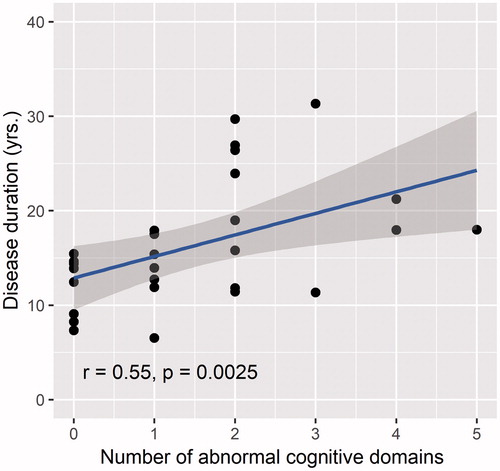Figures & data
Table 1 Demographic and clinical characteristics.
Table 2 Overview neuropsychological test battery.
Table 3 Neuropsychological test results.
Table 4 Neuropsychological profiles of individual PLS patients based on the NPE and the ECAS behavioral interview.
Figure 1 Classification of patients according to the revised Strong consensus criteria. *The proportion of the total of patients (n = 30) included in the study categorized according to the revised consensus criteria for the diagnosis of frontotemporal dysfunction in amyotrophic lateral sclerosis (ALS) by Strong, et al.[Citation34]. bvFTD: behavioral variant frontotemporal dementia; BI: behavioral impairment; CBI: cognitive and behavioral impairment; CI: cognitive impairment; D: ALS with dementia, not typical of FTD; *aMCI: amnestic mild cognitive impairment, not part of the revised Strong consensus criteria.
![Figure 1 Classification of patients according to the revised Strong consensus criteria. *The proportion of the total of patients (n = 30) included in the study categorized according to the revised consensus criteria for the diagnosis of frontotemporal dysfunction in amyotrophic lateral sclerosis (ALS) by Strong, et al.[Citation34]. bvFTD: behavioral variant frontotemporal dementia; BI: behavioral impairment; CBI: cognitive and behavioral impairment; CI: cognitive impairment; D: ALS with dementia, not typical of FTD; *aMCI: amnestic mild cognitive impairment, not part of the revised Strong consensus criteria.](/cms/asset/c2ab08ef-8db1-4eff-a1e5-29248fa67038/iafd_a_1620284_f0001_c.jpg)
Figure 2 Correlation between disease duration and the number of abnormal cognitive domains. The number of abnormal cognitive domains (performance ≤5th percentile) varied between 0–5, with a theoretical maximum of 6: executive functions, social cognition, fluency, language, memory and visuospatial functions.

